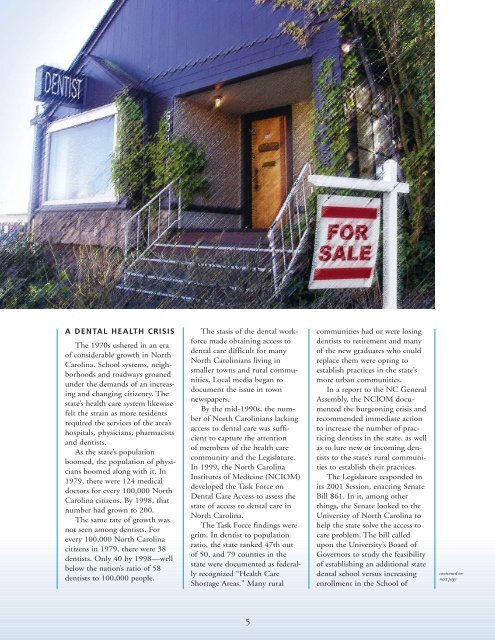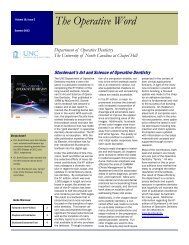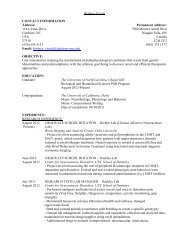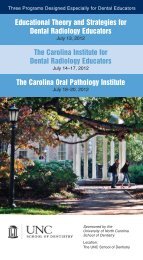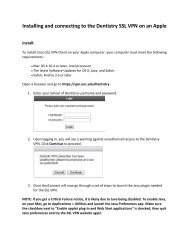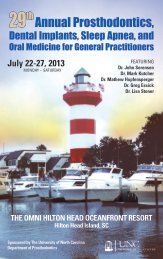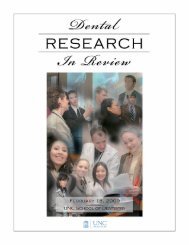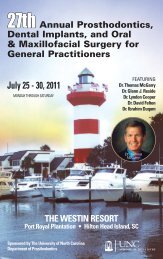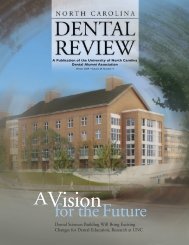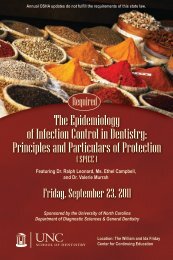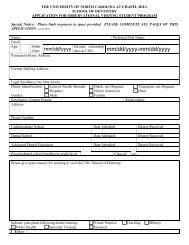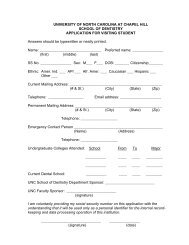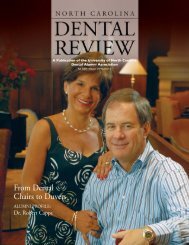Fall 2005 - UNC School of Dentistry - The University of North ...
Fall 2005 - UNC School of Dentistry - The University of North ...
Fall 2005 - UNC School of Dentistry - The University of North ...
Create successful ePaper yourself
Turn your PDF publications into a flip-book with our unique Google optimized e-Paper software.
A DENTAL HEALTH CRISIS<strong>The</strong> 1970s ushered in an era<strong>of</strong> considerable growth in <strong>North</strong>Carolina. <strong>School</strong> systems, neighborhoodsand roadways groanedunder the demands <strong>of</strong> an increasingand changing citizenry. <strong>The</strong>state’s health care system likewisefelt the strain as more residentsrequired the services <strong>of</strong> the area’shospitals, physicians, pharmacistsand dentists.As the state’s populationboomed, the population <strong>of</strong> physiciansboomed along with it. In1979, there were 124 medicaldoctors for every 100,000 <strong>North</strong>Carolina citizens. By 1998, thatnumber had grown to 200.<strong>The</strong> same rate <strong>of</strong> growth wasnot seen among dentists. Forevery 100,000 <strong>North</strong> Carolinacitizens in 1979, there were 38dentists. Only 40 by 1998—wellbelow the nation’s ratio <strong>of</strong> 58dentists to 100,000 people.<strong>The</strong> stasis <strong>of</strong> the dental workforcemade obtaining access todental care difficult for many<strong>North</strong> Carolinians living insmaller towns and rural communities.Local media began todocument the issue in townnewspapers.By the mid-1990s, the number<strong>of</strong> <strong>North</strong> Carolinians lackingaccess to dental care was sufficientto capture the attention<strong>of</strong> members <strong>of</strong> the health carecommunity and the Legislature.In 1999, the <strong>North</strong> CarolinaInstitutes <strong>of</strong> Medicine (NCIOM)developed the Task Force onDental Care Access to assess thestate <strong>of</strong> access to dental care in<strong>North</strong> Carolina.<strong>The</strong> Task Force findings weregrim. In dentist to populationratio, the state ranked 47th out<strong>of</strong> 50, and 79 counties in thestate were documented as federallyrecognized “Health CareShortage Areas.” Many ruralcommunities had or were losingdentists to retirement and many<strong>of</strong> the new graduates who couldreplace them were opting toestablish practices in the state’smore urban communities.In a report to the NC GeneralAssembly, the NCIOM documentedthe burgeoning crisis andrecommended immediate actionto increase the number <strong>of</strong> practicingdentists in the state, as wellas to lure new or incoming dentiststo the state’s rural communitiesto establish their practices.<strong>The</strong> Legislature responded inits 2001 Session, enacting SenateBill 861. In it, among otherthings, the Senate looked to the<strong>University</strong> <strong>of</strong> <strong>North</strong> Carolina tohelp the state solve the access tocare problem. <strong>The</strong> bill calledupon the <strong>University</strong>’s Board <strong>of</strong>Governors to study the feasibility<strong>of</strong> establishing an additional statedental school versus increasingenrollment in the <strong>School</strong> <strong>of</strong>continued onnext page5


